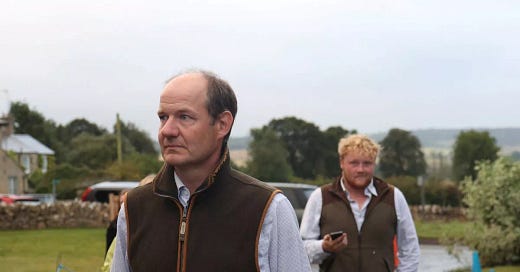The ubiquitous gilet
Something I wrote recently for The Spectator on how the gilet took over the middle class wardrobe especially in the wine world.
Last summer I attended a reunion at my prep school, the occasion was the leaving of a much-loved master. I thought the appropriate thing to wear would be a tweed jacket in honour of prep school masters everywhere. But I found myself woefully over-dressed as pretty much all my contemporaries were wearing gilets. It was a similar story at the Fortnum & Mason awards, the Oscars of the British food and drink scene, I wore a suit but there were William Sitwell and others casually sporting gilets. When did this item of clothing become ubiquitous?
When I was growing up the only people who wore gilets were fishermen, farmers and Michael J. Fox in Back to the Future. Furthemore, they weren’t called gilets, they were called body warmers or sleeveless coats. Gilet is a French word, though it has very different connotations there thanks to the antics of les gilet jaunes in the last few years, less hunting and shooting, and more burning and looting.
The gilet has completely taken over the wine world. Rather than the tweed jacket and red trousers of yore, the modern wine man or woman wears jeans, a gilet, preferably emblazoned with the name of a producer, and brown leather boots for tramping around vineyards. I think part of the reason why English wine producers, especially ex-City Boys, love it so much is it suggests that the wearer is more involved with the agricultural side of the business than he really is. A gilet says that the wearer is equally at home in the boardroom and the fields. It’s the same affectation as driving a Range Rover in Kensington.
Perhaps the apotheosis of this style is Charlie Ireland, the adviser from Clarkson’s Farm, who whether he’s in the office or out in the fields discussing crop yield, is rarely without a green sleeveless fleece with smart leather piping. If you want to ape his look, only one brand will do, Schöffel. So popular has this Bavarian company become that its £150 gilets are now known as Cotswolds/ Chelsea (delete as appropriate) life jackets. Though a Lincolnshire gentleman farmer told me: “Schöffel is done. Strictly for trainee land agents” and recommends getting something in Donegal tweed from Magee 1886. Yours for around £250.
You can spend a lot more. Net-a-Porter will sell you gilets from Brunello Cucinelli for up to £4,000 - for a coat without sleeves! These kinds of stealth luxury items have proved particularly popular since Succession where Jeremy Strong as Kendall Roy wore a series of high end gilets paired with his trademark baseball cap. Gilets have proved massively popular with businesses looking to plant their logos, replacing the 1990s golfing umbrella as the branded merch of choice. Rocking your hedge fund gilet at the school sports day is a great way of saying, I am casual and raking it in.
As you might have guessed I am something of a gilet-sceptic. Or I was, until a couple of years ago when I went on a press trip to a distillery in Scotland and we were each issued with a branded fleece-lined gilet. It was a revelation: snugly warm when you zip it up, but not claustrophobic, flattering on my middle-aged frame and full of handy pockets. Truly it’s the perfect item for the changeable British weather. Just not to parties, please. Have some standards.





Ah the vest, as known also in Canada and a necessary apparel of our world to keep the heart/lungs warm, with the arms free to drink coffee topped up with *whatever your fancy...having lived in Cambridge, UK and Ireland as an equestrian it is the perfect piece of clothing to take you from the yard to the pub for a pint after. While I always stumbled over ‘gilet’, watching the punters go around at Burghley in their gilet of choice, it always made me feel I was living the quintessential life of a Brit.
And at weekend auctions full of Victorian furniture and pseudo-serious art out in the countryside, well-polished Lobb or Church shoes finish the look for casually rapacious Londoners….